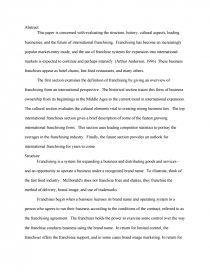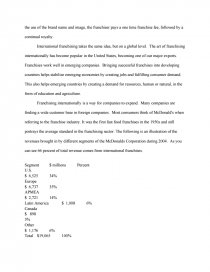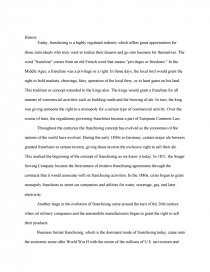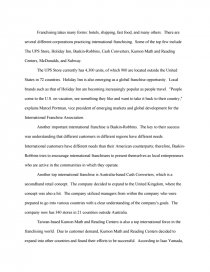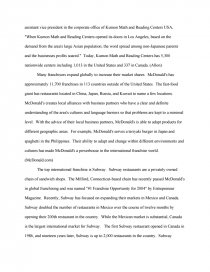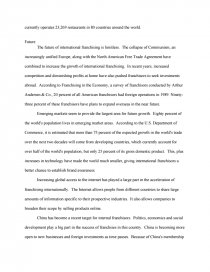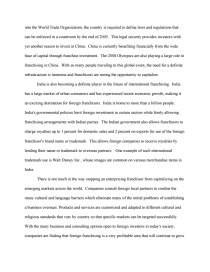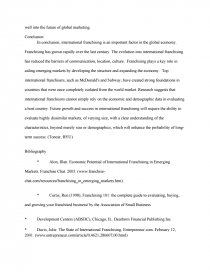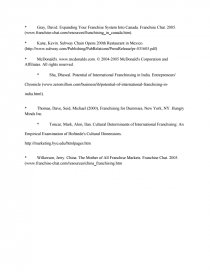International Franchising
Essay by review • December 29, 2010 • Research Paper • 2,622 Words (11 Pages) • 1,508 Views
Abstract
This paper is concerned with evaluating the structure, history, cultural aspects, leading businesses, and the future of international franchising. Franchising has become an increasingly popular market-entry mode, and the use of franchise systems for expansion into international markets is expected to continue and perhaps intensify. (Arthur Anderson, 1996) These business franchises appear as hotel chains, fast food restaurants, and many others.
The first section examines the definition of franchising by giving an overview of franchising from an international perspective. The historical section traces this form of business ownership from its beginnings in the Middle Ages to the current trend in international expansion. The cultural section evaluates the cultural elements vital to creating strong business ties. The top international franchises section gives a brief description of some of the fastest growing international franchising firms. This section uses leading competitor statistics to portray the averages in the franchising industry. Finally, the future section provides an outlook for international franchising for years to come.
Structure
Franchising is a system for expanding a business and distributing goods and services - and an opportunity to operate a business under a recognized brand name. To illustrate, think of the fast food industry. McDonald's does not franchise fries and shakes, they franchise the method of delivery, brand image, and use of trademarks.
Franchises begin when a business licenses its brand name and operating system to a person who agrees to run their business according to the conditions of the contract, referred to as the franchising agreement. The franchiser holds the power to exercise some control over the way the franchise conducts business using the brand name. In return for limited control, the franchiser offers the franchisee support, and in some cases brand image marketing. In return for the use of the brand name and image, the franchiser pays a one time franchise fee, followed by a continual royalty.
International franchising takes the same idea, but on a global level. The art of franchising internationally has become popular in the United States, becoming one of our major exports. Franchises work well in emerging companies. Bringing successful franchises into developing countries helps stabilize emerging economies by creating jobs and fulfilling consumer demand. This also helps emerging countries by creating a demand for resources, human or natural, in the form of education and agriculture.
Franchising internationally is a way for companies to expand. Many companies are finding a wide customer base in foreign companies. Most consumers think of McDonald's when referring to the franchise industry. It was the first fast food franchises in the 1950s and still portrays the average standard in the franchising sector. The following is an illustration of the revenues brought in by different segments of the McDonalds Corporation during 2004. As you can see 66 percent of total revenue comes from international franchises.
Segment $ millions Percent
U.S.
$ 6,525 34%
Europe
$ 6,737 35%
APMEA
$ 2,721 14%
Latin America $ 1,008 6%
Canada
$ 898
5%
Other
$ 1,176 6%
Total $19,065 100%
History
Today, franchising is a highly regulated industry which offers great opportunities for those individuals who truly want to realize their dreams and go into business for themselves. The word "franchise" comes from an old French word that means "privileges or freedoms." In the Middle Ages, a franchise was a privilege or a right. In those days, the local lord would grant the right to hold markets, showings, fairs, operation of the local ferry, or to hunt game on his land. This tradition or concept extended to the kings also. The kings would grant a franchise for all manner of commercial activities such as building roads and the brewing of ale. In turn, the king was giving someone the right to a monopoly for a certain type of commercial activity. Over the course of time, the regulations governing franchises became a part of European Common Law.
Throughout the centuries the franchising concept has evolved as the economies of the nations of the world have evolved. During the early 1800s in Germany, certain major ale brewers granted franchises to certain taverns, giving those taverns the exclusive right to sell their ale. This marked the beginning of the concept of franchising as we know it today. In 1851, the Singer Sewing Company became the forerunners of modern franchising agreements through the contracts that it would associate with its franchising activities. In the 1880s, cities began to grant monopoly franchises to street car companies and utilities for water, sewerage, gas, and later, electricity.
Another stage in the evolution of franchising came around the turn of the 20th century when oil refinery companies and the automobile manufacturers began to grant the right to sell their products.
Business format franchising, which is the dominant mode of franchising today, came onto the economic scene after World War II with the return of the millions of U.S. servicemen and women causing the subsequent baby boom. Franchising became the ideal business model for the rapid expansion of the hotel/motel and fast food industries. International franchising started its beginnings in the early 1960's. However, the explosion of the 1960s and 70s saw many forms of abuse in the franchising industry. There were also a number of totally fraudulent franchise companies that literally took peoples money and ran. There were many companies that were undercapitalized and poorly managed which led to bankruptcy, leaving a trail of failed franchisees that lost everything.
Cultural Influences
Franchising has become an increasingly popular foreign market-entry mode and the use of franchise systems for expansion into international markets is expected to continue and perhaps intensify. Franchisors have began to
...
...
